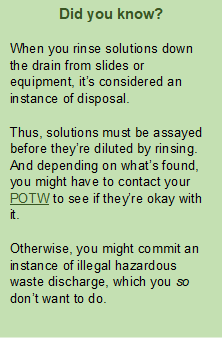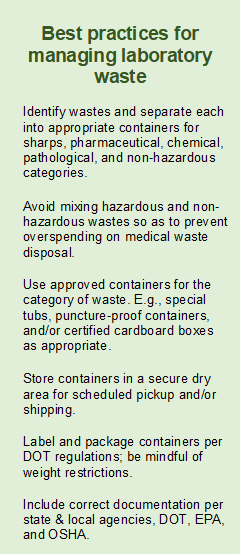A Primer On Laboratory Waste Disposal
March 15, 2022
Whether from workaday medical tests and procedures, or exotic research and experimentation, there are three kinds of hazardous waste that are endemic to laboratories. These would be (1) chemical wastes, (2) infectious wastes, and (3) pathological wastes—all of which will earn you the EPA’s great displeasure should they show up in your municipal waste stream.
Laboratory chemical waste
Chemical waste from analyzers, calibrators, cleaners, reagents, stains, and test kits must be assayed to determine if they require hazardous waste disposal per RCRA standards. And bear in mind that the constituents, contaminants, and preservatives found in these wastes can be considered RCRA hazardous at very scanty levels.
Complicating the picture, product inserts often don’t list data concerning lesser amounts of preservatives and contaminants that require hazardous waste management per the EPA (or state-specific lethality laws). Thus, it’s crucial to get expert advice about your laboratory waste to ensure you’re not inadvertently out of compliance despite your best efforts.
out of compliance despite your best efforts.
Examples of chemical waste in a laboratory might include:
- Fixatives (E.g. B-5 and Zenker’s)
- Clinitest tablets (used & unused)
- Parrafin/xylene
- Wright’s stain (used & unused)
- Hemocue Hgb cuvettes
Laboratory infectious wastes
Infectious wastes are also known as biohazardous wastes and are referred to as “red bag waste” by healthcare insiders. These include fluid blood or bulk body-fluids and human derived albumin, along with live or attenuated vaccines, cultures, biological agents, and related lab items that are infectious to humans.
Your garbage requires hazardous waste disposal if it includes:
- Anything that’s been soaked in blood (gloves, gauze, gowns, etc.)
- Cultures of infectious diseases and/or agents
- Discarded vaccines, antibiotics, pills, and other pharmaceuticals
- Human or animal tissues
- Disinfectants and solvents used for laboratory purposes
- Batteries and heavy metals from decommissioned lab equipment
- Anything carcinogenic, teratogenic, or mutagenic
Once in the hands of a reputable and properly licensed hazardous waste disposal company, these materials are rendered safe in one of three ways:
- Autoclaving. About 90 percent of biohazardous waste is incinerated this way. The material is placed in a specialized container at high levels of temperature and pressure to be consequently destroyed. Or it’s zapped in a microwave-on-steroids to exact the same effect.
- Chemical Disinfection. Some biohazardous wastes can be chemically disinfected and then landfilled like any other kind of waste.
- Encapsulation. This is used for “sharps,” which is contaminated material that can easily puncture conventional waste containers and thereby spread their evil. The most obvious of these are syringes. This kind of stuff is “encapsulated” into puncture-proof containers and segregated from the more-pedestrian garbage in landfills.
Laboratory pathological and large tissue waste
Pathological and large tissue wastes include such offal as human tissues and body parts (whether removed by accident, surgery, or autopsy), along with carcasses, body parts, and blood-derived from research animals (that are infectious to humans).
Pathological and large tissue wastes should be placed in yellow bags rather than the aforementioned red. And they require autoclaving, as neither chemical disinfection nor encapsulation is options.
Best practices for managing laboratory waste
First of all, try not to purchase more than you need of anything that will be considered hazardous when time comes to dispose of it, used or unused. Avoid bulk purchases, because volume discounts are moot if a product expires and has to be tossed. This might sound like pedestrian advice but remember that “transient” supply-chain problems militate against it: staff & management don’t want to be caught short, so they tend to overbuy.
If it’s evident that you own more of something than you can possibly use before its expiration date, see if other facilities or departments in your professional network might be able to use it. Also remember that things like formalin, ethyl alcohol, and xylene are easily recycled, and doing so has its pecuniary advantages.
Interested agencies
Along with the EPA, at least three federal agencies have an interest in laboratory waste disposal rules:
- RMW is more dangerous the nearer it is to its point of generation and is, therefore, an occupational safety concern in addition to an environmental one. OSHA guidelines trump state & local ones if the latter are less strict.
- Regulated medical waste is considered a hazardous material, and its transportation is consequently subject to applicable DOT rules.
- CDC. Medical waste disposal methods must adhere to CDC guidelines for infection control.
Safe & legal disposal: your goal
Once your laboratory wastes are properly identified, categorized, and separated, you must ensure that they’re transported to the correct category of waste disposal facility. E.g., there are chemical wastes vs. biological wastes vs. corrosive wastes vs. reactive wastes, etc., and different facilities are “permitted” to transport them—and some definitely aren’t.
Fortunately, there are companies that make it their business to match you (and your hazardous waste) to the transporter and/or disposer that can keep you out of trouble.
If you are searching for a company to help you with your laboratory waste, we can help. Fill out this form to get a quote today.

